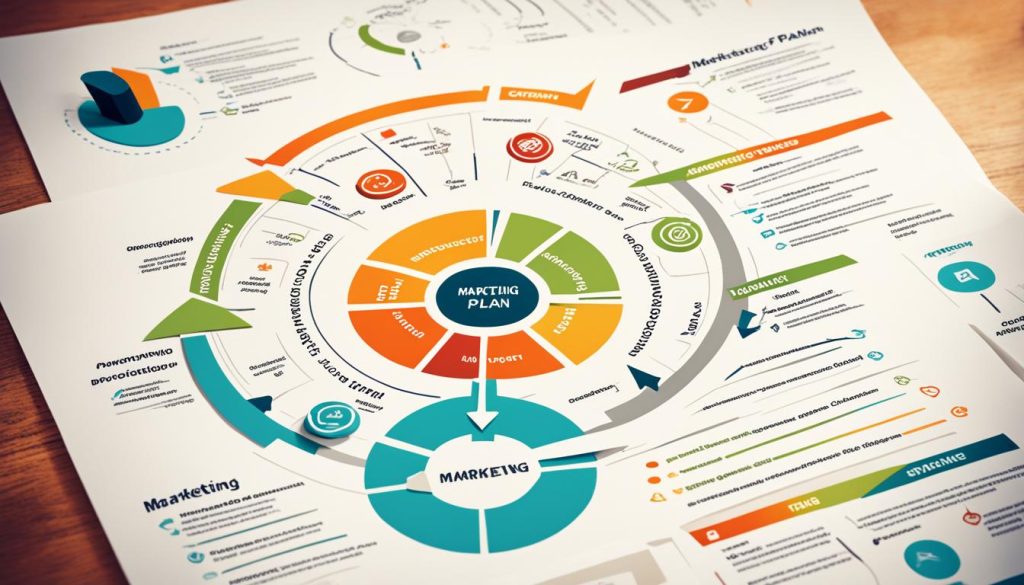Welcome to our guide on how to write a marketing plan, a crucial document that outlines your marketing strategy and tactics to achieve your business goals. Whether you’re a small business owner, a marketing professional, or an entrepreneur looking to launch a new product, having a well-thought-out marketing plan is essential for success.
In this blog post, we’ll take you through the step-by-step process of creating a comprehensive marketing plan that aligns with your business objectives. We’ll cover everything from conducting market research and identifying your target audience to setting measurable goals and implementing your marketing strategies. By the end of this guide, you’ll have the knowledge and tools to create a powerful marketing plan that drives growth and helps you reach your target market effectively. Let’s dive in!
What is a Marketing Plan?
A marketing plan is a strategic document that outlines marketing objectives, strategies, and tactics. It serves as a roadmap to help businesses stay on track and measure the success of their campaigns. The purpose of a marketing plan is to organize strategies, keep teams aligned, and measure the effectiveness of marketing efforts. It is a subset of a business plan, focusing specifically on marketing strategies and how they support overall business goals.
Through careful planning and execution, a marketing plan enables businesses to:
- Identify target audiences and their needs
- Develop relevant and engaging content initiatives
- Allocate resources effectively
- Set measurable objectives and track progress
- Stay ahead of the competition
With a well-crafted marketing plan in place, businesses can make informed decisions, optimize their marketing efforts, and achieve their desired outcomes.

Benefits of a Marketing Plan
- Organized Strategy: A marketing plan provides a clear roadmap, allowing businesses to plan, execute, and evaluate marketing strategies and tactics.
- Team Alignment: With a marketing plan, all team members have a shared understanding of the objectives, target audience, and messaging, leading to a cohesive and unified approach.
- Measurable Results: A marketing plan includes key performance indicators (KPIs) that enable businesses to measure the success of their marketing campaigns and make data-driven decisions.
- Resource Optimization: By allocating resources strategically, businesses can optimize their marketing budget, time, and efforts to achieve maximum impact and return on investment.
Overall, a marketing plan serves as a vital tool for businesses to navigate the competitive landscape, connect with their target audience, and drive sustainable growth.
How to Write a Marketing Plan?
To write an effective marketing plan, follow these steps:
- Clearly state your business’s objectives and mission. This will guide your marketing strategies and ensure they align with your overall business goals.
- Determine key performance indicators (KPIs) to measure the success of your marketing efforts. These could include metrics such as website traffic, lead generation, or sales conversions.
- Identify your target audience. Understand their needs, preferences, and behaviors to tailor your marketing messages effectively.
- Develop content initiatives and strategies that will resonate with your target audience. This can include creating engaging blog posts, social media campaigns, or video content.
- Clearly define what will be included in your marketing plan and what aspects will be omitted. Stay focused on the strategies that will yield the best results for your business.
- Define your marketing budget. Allocate resources strategically to maximize the impact of your marketing activities.
- Analyze your competition. Understand their marketing strategies and identify opportunities to differentiate your business.
- Outline the contributors and their responsibilities within the marketing plan. Assign tasks and establish accountability to ensure smooth execution.

Following these steps will help you create an outstanding marketing plan that drives growth and success for your business.
Types of Marketing Plans
When creating a marketing plan, businesses have various options to choose from based on their goals and strategies. Let’s explore some of the types of marketing plans that can help businesses achieve their desired outcomes:
Traditional Marketing Plans
Traditional marketing plans involve offline strategies such as print advertisements, television commercials, radio promotions, and direct mail. These plans are often used by businesses targeting a specific geographic area or demographic.
Digital Marketing Plans
Digital marketing plans focus on online channels such as websites, search engine optimization (SEO), pay-per-click (PPC) advertising, email marketing, and social media marketing. These plans are effective for businesses looking to reach a broader audience and engage with customers through digital platforms.
Social Media Marketing Plans
Social media marketing plans specifically target social media platforms like Facebook, Instagram, Twitter, and LinkedIn. These plans capitalize on the power of social media to build brand awareness, connect with customers, and drive engagement and conversions.
Product Marketing Plans
Product marketing plans revolve around promoting and launching new products or services. These plans focus on key market research, product positioning, competitive analysis, and strategies to effectively market and sell the product.
To gain a better understanding of how these marketing plans function, businesses can refer to various examples and samples available online. These resources can provide guidance and inspiration to create a customized marketing plan that suits the specific needs of your small business.
Marketing Plan Examples
Looking for some inspiration to create your own marketing plan? Check out these marketing plan examples that showcase different strategies, tactics, and objectives tailored to various industries and businesses.
1. Small Business Marketing Plan Example
If you’re a small business owner, this sample marketing plan can provide valuable insights into creating an effective marketing strategy. It includes steps on defining your target audience, setting clear objectives, utilizing different marketing channels, and measuring your results to ensure success.
2. Product Marketing Plan Example
If you’re launching a new product or service, this marketing plan example can help you develop a comprehensive strategy. It covers aspects such as market research, product positioning, pricing strategies, promotional activities, and customer acquisition techniques to ensure a successful product launch.
3. Industry-Specific Marketing Plan Example
Every industry has unique marketing challenges and requirements. This marketing plan example tailored to your industry can provide valuable insights into effective strategies and tactics. Whether you’re in the technology, healthcare, or retail sector, you can find industry-specific marketing plan examples to enhance your marketing efforts.
Use these marketing plan examples as templates or starting points to create your own plan. Customize your strategies, tactics, and objectives to align with your unique business needs and goals. Remember, a well-crafted marketing plan is crucial for business success.

How to Write an Executive Summary for a Marketing Plan?
The executive summary is a crucial part of a marketing plan. It provides a concise and compelling overview of the entire plan, capturing the reader’s attention and conveying the essence of the strategies and goals. When crafting an executive summary, it is important to consider the target audience and tailor the content to their specific needs and preferences.
Here are the key elements that should be included in an executive summary for a marketing plan:
- Mission: Clearly state the purpose and mission of the marketing plan, highlighting the key objectives and desired outcomes.
- Goals: Summarize the specific goals and targets that the marketing plan aims to achieve, focusing on measurable results.
- Target Audience: Provide a brief description of the target audience, outlining their demographics, behaviors, and preferences.
- Strategies: Outline the main strategies and tactics that will be implemented to reach the target audience and achieve the marketing goals.
- Budget: Include a summary of the allocated budget for the marketing plan, demonstrating resource allocation and financial considerations.
Writing an executive summary for a marketing plan requires careful thought and attention to detail. It should highlight the most important aspects of the plan while maintaining brevity. By effectively communicating the mission, goals, strategies, and budget, the executive summary sets the stage for the rest of the plan.
Example Executive Summary for a Marketing Plan:
| Element | Summary |
|---|---|
| Mission | To increase brand awareness and customer acquisition through targeted digital marketing campaigns. |
| Goals | 1. Increase website traffic by 30% within the next six months. 2. Generate 20% more qualified leads through lead nurturing strategies. 3. Achieve a 15% conversion rate on the e-commerce platform. |
| Target Audience | Millennial professionals aged 25-35, located in urban areas, with an interest in sustainable fashion. |
| Strategies | 1. Launch a content marketing campaign focused on sustainability in fashion. 2. Implement targeted social media advertising to reach the target audience. 3. Collaborate with relevant influencers and fashion bloggers to increase brand visibility. |
| Budget | An allocated budget of £50,000 for the marketing plan, divided across digital advertising, content creation, and influencer partnerships. |
By following these guidelines and considering the specific needs of the target audience, you can create an impactful executive summary that sets the stage for a successful marketing plan.

How to Write a Conclusion for a Marketing Plan?
The conclusion of a marketing plan is a crucial element that provides a concise summary of the key points discussed throughout the plan. It serves to highlight the main takeaways and reinforce the alignment of the plan with the overall goals for business growth. Writing a compelling conclusion plays a vital role in inspiring confidence in the marketing plan and guiding the reader towards the next steps.
When crafting a conclusion for a marketing plan, consider the following steps:
- Summarize the strategies and objectives: Begin by summarizing the marketing strategies and objectives outlined in the plan. This helps reinforce the main focus areas and ensures a clear understanding.
- Emphasize the value and potential impact: Highlight the value and potential impact of the marketing initiatives. Emphasize the benefits that the plan can bring to the business and how it aligns with the overall goals.
- Reinforce alignment with business goals: Connect the marketing plan to the broader business goals and objectives. Showcase the strategic importance of the plan and demonstrate how it contributes to the overall success of the organization.
- Provide a summary of key points: Summarize the key points discussed in the marketing plan, focusing on the most critical aspects. This helps create a cohesive and complete picture for the reader.
- Leave the reader with clear next steps: Conclude the marketing plan by clearly outlining the next steps that need to be taken. Whether it’s implementing specific strategies, conducting further research, or reviewing progress, ensure the reader knows what to do next.
A well-crafted conclusion for a marketing plan not only summarizes the plan but also leaves the reader with a sense of confidence and direction. It ties together the elements of the plan, reiterates its value, and guides the reader towards successful implementation.
Conclusion
Writing a marketing plan is essential for businesses to effectively execute their marketing strategies and achieve their goals. By following the steps outlined in this guide, businesses can create a comprehensive and results-driven marketing plan. Whether it’s a traditional, digital, or social media marketing plan, the key is to define the mission, set measurable goals, identify the target audience, develop relevant content initiatives, allocate resources strategically, analyze the competition, and outline contributors’ responsibilities. With a well-crafted marketing plan in place, businesses can navigate the ever-changing market landscape and drive growth and success.





